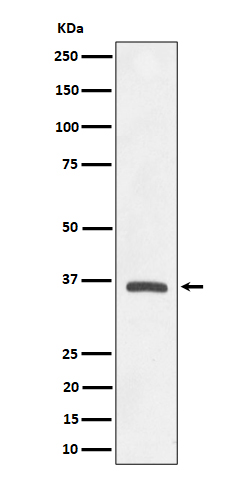Anti-OXGR1 / GPR99 Rabbit Monoclonal Antibody
- SPECIFICATION
- CITATIONS
- PROTOCOLS
- BACKGROUND

Application
| WB, IF, ICC, FC |
|---|---|
| Primary Accession | Q96P68 |
| Host | Rabbit |
| Isotype | IgG |
| Reactivity | Rat, Human, Mouse |
| Clonality | Monoclonal |
| Format | Liquid |
| Description | Anti-OXGR1 / GPR99 Rabbit Monoclonal Antibody . Tested in WB, ICC/IF, Flow Cytometry applications. This antibody reacts with Human, Mouse, Rat. |
| Gene ID | 27199 |
|---|---|
| Other Names | 2-oxoglutarate receptor 1, Alpha-ketoglutarate receptor 1, G-protein coupled receptor 80, G-protein coupled receptor 99, P2Y purinoceptor 15, P2Y15, P2Y-like GPCR, P2Y-like nucleotide receptor, OXGR1, GPR80, GPR99, P2RY15, P2Y15 |
| Calculated MW | 36 kDa |
| Application Details | WB 1:500-1:2000 ICC/IF 1:50-1:200 FC 1:50 |
| Contents | Rabbit IgG in phosphate buffered saline, pH 7.4, 150mM NaCl, 0.02% sodium azide and 50% glycerol, 0.4-0.5mg/ml BSA. |
| Clone Names | Clone: 29O18 |
| Immunogen | A synthesized peptide derived from human OXGR1 / GPR99 |
| Purification | Affinity-chromatography |
| Storage | Store at -20°C for one year. For short term storage and frequent use, store at 4°C for up to one month. Avoid repeated freeze-thaw cycles. |
| Name | OXGR1 |
|---|---|
| Function | G protein-coupled receptor for dicarboxylates and amino dicarboxylates (PubMed:15141213, PubMed:36571463, PubMed:36919698). Receptor for itaconate, a metabolite produced by myeloid lineages (PubMed:36919698). In the respiratory epithelium, couples the binding of itaconate to the activation of GNA11 and downstream intracellular Ca(2+) release, leading to mucocilliary clearance of airborne pathogens (PubMed:36919698). Receptor for leukotriene E4 (LTE4) produced by mast cells upon allergic inflammation. Binds with high affinity to LTE4 and elicits mucin release from pulmonary epithelium in response to airborne fungi allergens. Regulates mucin-producing goblet cell homeostasis (By similarity). Receptor for alpha-ketoglutarate produced by proximal tubule renal cells upon metabolic alkalosis. In an intrarenal paracrine signaling pathway, binds alpha-ketoglutarate and drives transepithelial salt reabsorption and bicarbonate secretion by SLC26A4/pendrin-positive intercalated cells (By similarity) (PubMed:15141213). |
| Cellular Location | Cell membrane; Multi-pass membrane protein. Note=Upon itaconate binding, internalizes via endocytosis in a beta-arrestin dependent manner |
| Tissue Location | Detected in kidney and, to a lower extent, in placenta. Not detected in brain tissues including the frontal cortex, caudate putamen, thalamus, hypothalamus, hippocampus or pons |

Thousands of laboratories across the world have published research that depended on the performance of antibodies from Abcepta to advance their research. Check out links to articles that cite our products in major peer-reviewed journals, organized by research category.
info@abcepta.com, and receive a free "I Love Antibodies" mug.
Provided below are standard protocols that you may find useful for product applications.
If you have used an Abcepta product and would like to share how it has performed, please click on the "Submit Review" button and provide the requested information. Our staff will examine and post your review and contact you if needed.
If you have any additional inquiries please email technical services at tech@abcepta.com.













 Foundational characteristics of cancer include proliferation, angiogenesis, migration, evasion of apoptosis, and cellular immortality. Find key markers for these cellular processes and antibodies to detect them.
Foundational characteristics of cancer include proliferation, angiogenesis, migration, evasion of apoptosis, and cellular immortality. Find key markers for these cellular processes and antibodies to detect them. The SUMOplot™ Analysis Program predicts and scores sumoylation sites in your protein. SUMOylation is a post-translational modification involved in various cellular processes, such as nuclear-cytosolic transport, transcriptional regulation, apoptosis, protein stability, response to stress, and progression through the cell cycle.
The SUMOplot™ Analysis Program predicts and scores sumoylation sites in your protein. SUMOylation is a post-translational modification involved in various cellular processes, such as nuclear-cytosolic transport, transcriptional regulation, apoptosis, protein stability, response to stress, and progression through the cell cycle. The Autophagy Receptor Motif Plotter predicts and scores autophagy receptor binding sites in your protein. Identifying proteins connected to this pathway is critical to understanding the role of autophagy in physiological as well as pathological processes such as development, differentiation, neurodegenerative diseases, stress, infection, and cancer.
The Autophagy Receptor Motif Plotter predicts and scores autophagy receptor binding sites in your protein. Identifying proteins connected to this pathway is critical to understanding the role of autophagy in physiological as well as pathological processes such as development, differentiation, neurodegenerative diseases, stress, infection, and cancer.


